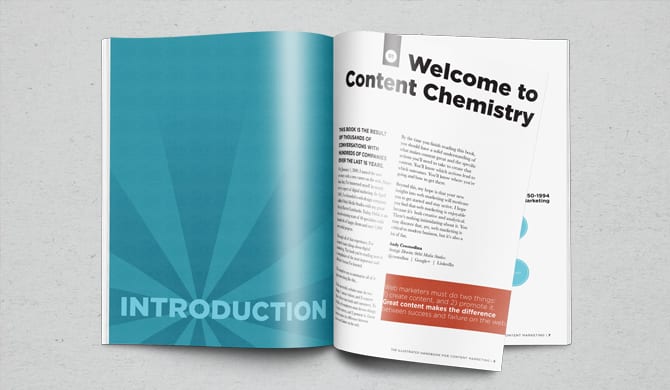Writing, by itself, is not enough to guarantee the success of your book. Success is based as much on how effectively you position your book relative to its competition as the quality and relevance of your message and your ability to write.
In my book coaching, I’ve been using Andy Crestodina’s Content Chemistry as an example of book positioning best practices in action. In fact, during my recent interview with Andy, we devoted the majority of our time to discussing ways to position nonfiction books relative to their competition.
After our call, I further “reverse engineered” Andy’s book, looking for an easy way to help new authors evaluate their book’s position before starting to write. This lead to the 10 questions that follow, and the simple book-checklist described below.
10 Questions to Ask Yourself
The relevance of the 10 questions, of course, extends beyond books and ebooks, You can use the questions during the planning stages of all types of content marketing; presentations, speeches, videos, webinars, and white papers, etc.
1. Does your book’s title offer a significantly different promise than competing books?
The title of your book plays a make-or-break role in your book’s success. It’s your book’s introduction to prospective readers—and, we all know the importance of first impressions.
Your title and subtitle have to not only arouse interest and describe the benefits readers will gain, but they have to make a different promise than the other books competing for your reader’s attention.
It’s not enough to simply describe your book’s contents. If you do, your book will be just one more Guide, Introduction, or similar source of information.
The core strength of Content Chemistry: An Illustrated Handbook for Content Marketing, lies the words, “Illustrated” and “Handbook.”
- “Illustrated” promises an easier learning experience, an alternative, in Andy’s words during our interview, to a “gray wall of words” on each page.
- “Handbook” also promises a different reading experience. A handbook promises an informal, practical, task-oriented, approach; a book I can scribble in and mark up.
2. Is your title as resonant and easy to remember as the titles of competing books?
Resonance is a measure of the emotional response your title arouses. A resonant title creates a meme—or recognizable image–in the mind of prospective reader. Jay Conrad Levinson created a 30-year, 125-title, all-time bestselling marketing book series around the Guerrilla Marketing brand.
Content Chemistry, likewise, creates an appropriate recognizable image, and memorable image in the prospective reader’s mind. It’s appropriate because it previews the book’s organization into Part One: Lecture and Part Two: Lab. It also sets the stage for the book’s signature Periodic Table of Content.
Finally, the title resonates because of the alliteration of the consonants, or “hard c’s” that begin both words.
3. How does the size, shape, and length of your book compare to the titles of competing books?
In an age of ebooks, it’s easy to overlook the importance of the physical characteristics of printed books. But, if you plan to sell printed copies of your book in bookstores or at events where you’re speaking, it’s important to pay attention to your book’s presence on a shelf or when held in your hand. Printed books differ in terms of size, shape, and length—or number of pages. Selecting a unique size, shape, and length is especially important if you want your book to serve as your business card, or you’re looking for an advantage in a world where everyone’s biggest challenge is a lack of time:.
- The presence created by a unique size, shape, and length sets your book stand out when handed to prospective clients, send to speaker’s bureaus and corporate event managers, or when marketed to attendees.
- In a busy world, a thinner book promises to save time. Brevity and conciseness are desired attributes in a world where the biggest challenge is a lack of time. If your book promises an easier, faster reading experience, it will enjoy a compelling advantage.
Content Chemistry’s combination of larger pages, square shape, and fewer pages creates a compelling alternative to competing books which tend to be smaller, rectangular, and thicker:
- Because it’s thinner, it’s easier to take Content Chemistry with you, slipping it into a backpack or laptop case.
- Because the pages are larger and square, there’s more white space on each page, and there’s room for readers to take notes while reading.
4. How does your book’s use of color, layout, text, and graphics differ from other books?
Apple’s iPods, iPhones, and iPads have proven that design is a competitive tool that attracts favorable attention and contributes to long-term buyer satisfaction. Traditionally, most design attention has been placed on front covers that make a quality statement that showcases the title’s promise.
But, as Content Chemistry shows, inside page design is an equally powerful positioning tool, one that offers both functional and emotional benefits. On a functional level, Content Chemistry’s larger page size and square shape offers designers the space and flexibility to showcase a broad mix of text and graphic elements.
- Easier to read. Readability is a measure of how easy text is to read. Readability results from a balanced approach to typeface, type size, line length, and line spacing. Content Chemistry’s larger pages allowed designers to optimize text for maximum readability, while building generous amounts of white space on each page.
- Better organized ideas. The larger space permitted more obvious reader cues, i.e., a clear typographic hierarchy that clearly communicates the structure of the information on each page, or two-page spread. Headings for the main ideas are significantly larger than the headings of supporting ideas, making it easier for readers rapidly read without losing the context of each idea.
- More useful graphics. The larger pages also permit more options for sizing and placing graphics. Often, charts, graphs, and tables are too small to be useful. If there are questions or exercises, there’s usually not enough space to respond.
The restrained use of color and careful editing also contributes to Content Chemistry’s First Class image. The primary accent color, brown, is limited to the top level subheads (or section headers) in each chapter, the vertical margins framing each 2-page spread, icons, and occasional tables and graphics. Additional colors are only used where appropriate, such as pie charts.
Design helps positions Content Chemistry. Most topics are limited to a single page, or 2-page spread. Rarely are topics or paragraphs continued from one page to another. This obviously requires more careful editing, but the payoff is in a First Class, “Tiffany-box-like,” image that contributes to increased referrals.
5. How does the price of your book compare to the prices of other books in your field?
Price is one of the ways buyers evaluate potential purchases. Pricing is influenced by factors both within and beyond your control. Pricing, for example, is influenced by your competitively-driven decisions regarding the size, shape, length, and design of your book. Yet, your book’s price must also take into account the range of prices of competing books, especially the prices of the 2 or 3 most popular books in your category.
The more your book differs from its competitors, the more pricing flexibility you can enjoy. However, everyone likes to save money, especially in times like these. So it’s important to avoid the extremes of either pricing your book so low that you diminish its perceived value, or pricing it significantly higher than the competition.
6. Is your book written from a different perspective than competing books?
Perspective reflects your vision of your book, the type of readers you’re writing for, and the scope and depth of your book.
- Scope refers to the number of ideas, examples, suggestions, tips, etc., you include in your book.
- Depth refers to the amount of information and detail associated with the ideas, examples, and tips in your book.
An introductory book intended for newcomers, for example, will often have a broad scope, covering a lot of topics, but not going deeply into any one area. On the other hand, a book written for experienced readers may go much deeper into fewer topics.
The key is to write from a perspective that makes a unique promise, is in harmony with your business goals, and is appropriate for the size, shape, length, design, and price decisions discussed above.
Ultimately, the perspective you choose determines your selectivity when deciding what to include and what to leave out of your book.
At a time when many competing books cover content marketing from a broad perspective, highlighting a range of content marketing tasks and examples, Content Chemistry provides a selective approach that delivers more information (depth) about fewer topics (scope).
This results in a focused, personal approach emphasizing what really matters from the author’s unique, numbers-oriented, scientific perspective. It succeeds because of its unique balanced approach. (For example, it’s not Content Marketing from a Copywriter’s Perspective, but it covers copywriting from a results-driven, conversion perspective.)
7. How does your book’s structure and presentation compare to other books?
Before starting to plan and write your book, analyze the way competing books are organized into parts (i.e., sections) and chapters. You can view a book’s table of contents online, using Amazon.com’s Look Inside! feature. Or, you can view mind maps showing the structure of books in various fields, like those I have posted of the Top Content Marketing Books or the Top Productivity Books.
Today, top business and marketing books tend to be characterized by books with shorter chapters than before, organized into 3, 5, or even more Parts. A book with a few long chapters look harder to read than a book with multiple short chapters. Readers appreciate books with short chapters because they can read them in short sessions—perfect for commuting or travelling—and they enjoy a feeling of accomplishment each time they complete a chapter or section of the book.
Content Chemistry’s approach is unique because it replaces parts and chapters with Lecture and Lab sections of uneven length, subdivided into topics instead of chapters. Once again, the structure is functional and appropriately reflects the book’s Handbook position and perspective.
8. How does your book’s use of engagement tools differ from other books?
After you have chosen the right perspective for your book, your next positioning challenge involves engagement: getting book buyers to read your words and turn your ideas into action.
There are three types of engagement tools:
- Story. You can engage reader by sharing information and advice in a story format. Options include sharing lessons a character learns during a journey, as stories based on your experience, or as case studies and examples. Unfortunately, in many cases, the complexities of a story format can get in the way of conciseness, detracting from the key ideas you want your readers to remember and act on.
- Style. If you can write as you speak, you’ll gain a powerful positioning advantage. A conversational tone begins with empathy and understanding of your readers, communicated using frequent I’s and you’s. A key characteristic is an equal emphasis on sharing advice and describing the benefits of the advice. Done right, creates trust; it’s like you’re in the same room with your reader, walking them through the steps they need to take.
- Tools. Another category of engagement tools includes experienced-based shortcuts, which can save your readers time when they implement your ideas. These can take the form of cautions, checklists, exercises, notes, reminders, tips, templates, or worksheets.
Content Chemistry’s large, square pages and careful design provides space to separate the primary text on the page and brief “interjections,” like cautions, notes, and tips.
As you evaluate the engagement tools used in competing books, ask yourself;. “Do I feel the authors really understands my challenges?” Or, do you feel you’re in the back row of a stuffy classroom where the professor is reading a speech he’s been delivering for the past ten years?.
9. Does your book appear more likely to inspire immediate action than other books?
Regardless of the quality of the information in competing books, how well they were written, or their price, the true measure of a book is its quality to inspire readers to take action.
Books are purchased by readers looking for change. They either have a problem they want to solve or a goal they want to achieve.
Experience, qualifications, and a wealth of information don’t ensure utility. Utility comes from focus, selectivity, and concisely delivering the right information in a pleasing format.
Take a fresh look at Content Chemistry, and critically compare its utility to other content marketing, social media, or Internet marketing books. Examine books in other categories, evaluating their ability to differentiate themselves from their competition and inspire readers to action.
10. How does your book’s value (price divided by benefits) compare to other books in your field?
Finally, evaluate Content Chemistry, or any other book—including your proposed book– from a value perspective. Analyze its ability to inspire change relative to its sales price.
This is revealing because this is exactly what your prospective readers are going to be doing–comparing features and benefits relative to cost.




